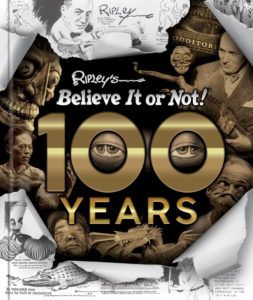Believing It (or Not) for 100 Years
Skip to comments
In December 1918 Leroy Robert Ripley came up with an idea that would make him famous … and rich. But he didn’t realize it then, and it wouldn’t be until the end of the following decade when his idea struck gold.
Robert, having dropped the Leroy, was a sports cartoonist for the New York Globe and Commercial Advertiser when he came up with a large panel he titled “Champs and Chumps.” The New York Globe published it on December 19, 1918.
The Globe was partnered with a syndicate and Ripley’s cartoons were distributed to other papers across the nation. So that Champs and Chumps oddity saw print in other cities, apparently for months after the December premiere. In a Believe It or Not moment what is recognized as the first Believe It or Not cartoon was published four days earlier (December 15, 1918) in The Washington (DC) Star, as discovered by Art Lortie. Ripley Inc. will, no doubt, keep the December 19 appearance in Ripley’s home paper as the official debut date.

above: Champs and Chumps appeared December 18, 1918 in the Buffalo Evening News
Champs and Chumps was a one-off idea, Ripley went back to his regular sports cartoons. Ten months later (October 16, 1919) he revisited the concept, this time titling it “Believe It or Not.” This title stuck, though it still wasn’t a regular feature – the third in the series arrived the next year, in 1920.
Now Ripley began to tie his wagon to the conceit. It began to appear weekly and then twice-weekly. In a couple of years he began running out of ideas so, in 1923, he hired Norbert Pearlroth as a research assistant. Through the 1920s the panel grew in popularity. Norbert quit his regular job to work full-time with Ripley. The panel, syndicated by Associated Newspapers, became a daily feature in newspapers.
And then he hit the big time!
Early in 1929 publishers Simon and Schuster, who had teamed up in 1924 to published crossword puzzle books, published a collection of Believe It or Not panels, it was a hit! By July of 1929 Ripley’s cartoon was being distributed by William Randolph Hearst and King Features Syndicate.
Max Schuster had wisely sent one of the first copies of Ripley’s book to William Randolph Hearst. After Hearst read it, he sent a wire to one of his editors in New York. It contained two words: “HIRE RIPLEY.” Ripley did not need much persuading, with Hearst offering a $1,200 a week salary plus a hefty share of the Believe it or Not sales profits, worth about $100,000 a year. He jumped with his cartoon to Hearst’s King Features Syndicate, and would remain there for the rest of his life.

above: the July 9, 1929 daily panel
(sources differ on the start date of King Features syndication – some say July 8, some say July 9).
Already touring the world and a regular on the lecture circuit, Ripley soon had a radio program and was doing movie shorts and opening up freak shows.
Success bred more success. By 1934, NBC had signed Ripley to a radio show (at $3,000 per half hour). Ripley negotiated further book deals with Simon & Schuster. When he renewed his contract with King Features, it was worth $7,000 a week. Twentieth Century Fox wanted a series of Believe It or Not movies. Ripley commanded $1,000 a night for a lecture. He was earning more than any cartoonist in the business. In 1933, at the Chicago World’s Fair, he inaugurated a new side venture, Ripley’s “Odditorium”—a gussied-up freak show. (Ripley would create more Odditoriums, including a Times Square flagship, precursors to the scores of Believe It or Not museums now operating around the world.) Ripley now had the means to live wherever and however he wished.
This left little time for the daily feature (the Sunday page started in October 1929) and Ripley handed it over to his assistants and ghosts.
Robert Ripley died in 1949. At that time “Believe It or Not” was officially retitled “Ripley’s Believe It or Not.” His name and his newspaper feature live on.
Ripley’s Believe It or Not had its origins 100 years ago today.
These days it is syndicated by Andrews McMeel Syndicate and done by researcher Sabrina Sieck and artist John Graziano. They celebrated the centennial anniversary on December 19, 2018:
The Ripley Odditoriums are also celebrating by giving away $100 bills
and free admission to those aged 100 years or older.
Allan Holtz on the early talents of Robert Ripley.
Vanity Fair on the history of Ripley’s Believe It Or Not!

The Katzenjammer Kids hit 100 years in 1997.
Gasoline Alley hit 100 years last month.
Next up for 100 is Barney Google and Snuffy Smith.




Comments
Comments are closed.